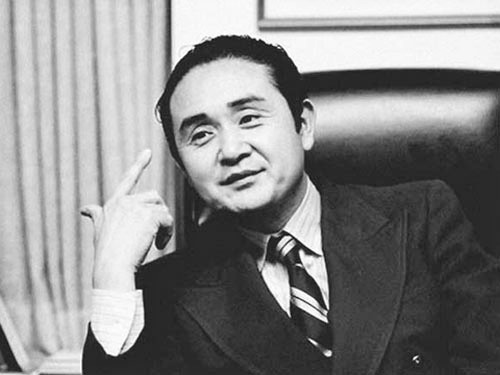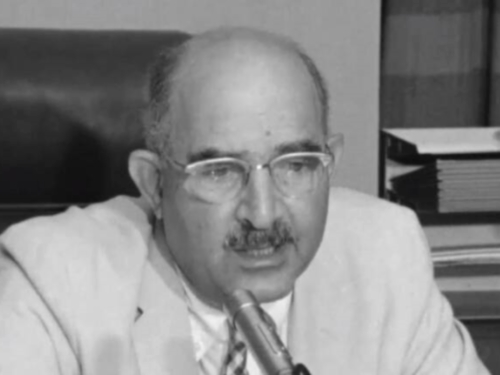Marilyn's Diary and Rashomon
Prior to 1974 and the publication of Robert Slatzer’s fantasy about his sixteen year relationship and brief marriage to Marilyn―it lasted a mere forty-eight hours during October of 1952, Slatzer claimed―her Red Book of Secrets, her Little Red Diary did not even exist. Frank Capell did not mention her diary in his brief anti-Robert Kennedy pamphlet and political hit piece, published in 1964; and in 1973, Norman Mailer did not mention a red diary in his vainglorious novel factoidal novel about a Marilyn that could have, might have existed, at least in his mind; and none of the contemporaneous articles of which I am aware, written after Marilyn’s death, mentioned her Red Book of Secrets. Possibly one of the most brazen liars, arguably the most brazen in the Realm of Marilyn created what was, and remains, an essential stage prop masquerading as evidence in the RFK-Murdered-MM-Industry, an industry that, with the publication of Bombshell, has reached the mountaintop.
I have written so much about Marilyn’s purported to be explosive diary, that metaphorically comparing myself to a busted stylus stuck in a misaligned record groove falls far short of the actual sensation of spinning in repetition. At any rate, I’ll touch upon a few important points about the alleged diary and its creation; and I’ll begin with this: an interviewer once asked Marilyn if she kept a diary. Well … not exactly a diary, she responded. Sometimes when things use to happen I use to write it down; but then, I use to tear it up. Her direct admission that she did not keep a diary as such has been summarily ignored.
Milo Speriglio, a private eye hired by Robert Slatzer, offered a $10K reward for Marilyn’s Little Red Diary. No one produced the book of secrets. Doug Villers later offered a substantially higher reward than Milo: six figures. I have read various accounts asserting that inordinately large amounts of money have been offered for Marilyn’s diary, the one she asserted she never kept. Regardless of the actual amount offered, no one has ever appeared with the book, along with their hand extended wanting payment. Several authors have written fictional accounts regarding what the mysterious red book possibly contained, Marilyn’s Red Diary, for example, written by Friedel. Creative authors might imagine what Marilyn’s diary actually contained; but arguably one of the most significant and most sought after written diaries in the history of written diaries has never been found, not even after forty-six years of intense publicity and intense searching.
But why only forty-six years? Why not over a half century or sixty-one years?―the span of time that has elapsed since Marilyn departed planet Earth. The legend of the Little Red Diary did not exist in 1962; the legend did not exist until Robert Slatzer published his apocryphal book, The Life and Curious Death of Marilyn Monroe, and introduced Marilyn’s Red Book of Secrets into her realm and thus into the world. For the first twelve years following Marilyn’s death, no one knew to search for her monumental and revelatory diary; and once the search began, the diary had already vanished, snatched from either Marilyn’s hacienda or from a safe in the coroners’ office. So, bereft of the actual diary itself, what credible, verifiable and tangible evidence has been offered as proof that this Red Book of Secrets actually ever existed? The short answer: none whatsoever. All the evidence offered has been either testimonial or anecdotal, often secondhand, consistently contradictory and as such, amounts to no evidence at all. So the pertinent question becomes: did Marilyn’s explosive diary ever exist at all?
Prior to the 1998 publication of Donald Wolfe’s The Last Days of Marilyn Monroe, only four persons actually claimed to have seen Marilyn’s diary and read the words she committed in longhand to its pages: Robert Slatzer, Jeanne Carmen, Ted Jordan and Samir Muqaddin AKA Lionel Grandison, Sr. Wolfe added a fifth name: Michael Rothmiller. According to Wolfe’s source notes, he interviewed Rothmiller in 1998. During that interview, Rothmiller evidently told Wolfe that Marilyn’s diary was more like a journal; and most of her entries memorialized her conversations with the middle Kennedy brothers.
Odd. Conversations are a shared activity, one person talking to another person; and even so, the alleged quotations from Marilyn’s red diary do not stipulate what John or Robert Kennedy actually said to Marilyn. Why is that?
Rothmiller reported to Wolfe that the diary contained other entries, though, ranging in topics from Frank Sinatra and the MOB to Cuba and the Soviet Union. Apparently Rothmiller did not reveal to Wolfe any more than the preceding brief account. Based on the revelations in Bombshell, then, and the knowledge that Rothmiller now asserts that he possessed in 1998, he did not exactly tell Donald Wolfe the complete truth, which is certainly a gross understatement. Even so, now, he expects us to believe his current revelations, that he spent hours reading Marilyn’s Red Book of Secrets and took extensive notes, which included a few transcriptions of the entries he had read.
Just like his assertions regarding the contents of Marilyn’s diary, which must be read to be appreciated, the level of their sophistry, that is, the three pages that appear in Bombshell as evidence that Rothmiller actually saw and read Marilyn’s Red Book of Secrets must be seen to be appreciated, the level of effrontery required to exhibit them, that is, foist them on a guileless and credulous public.
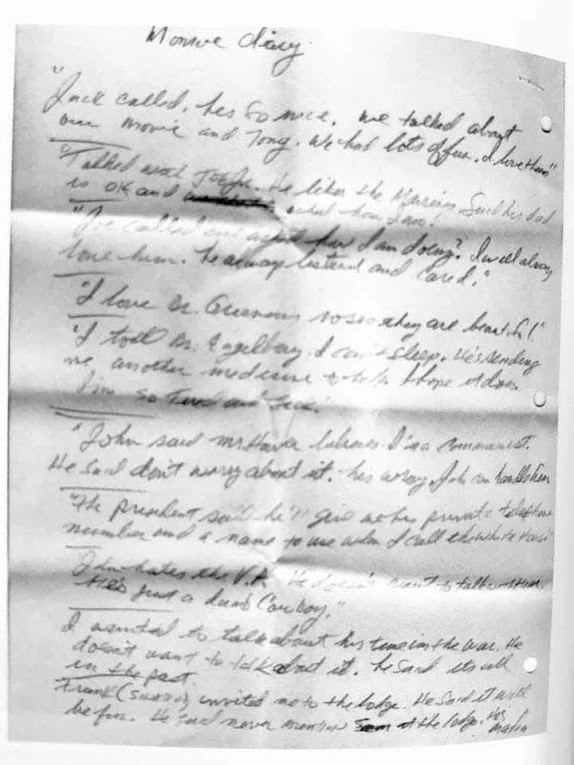

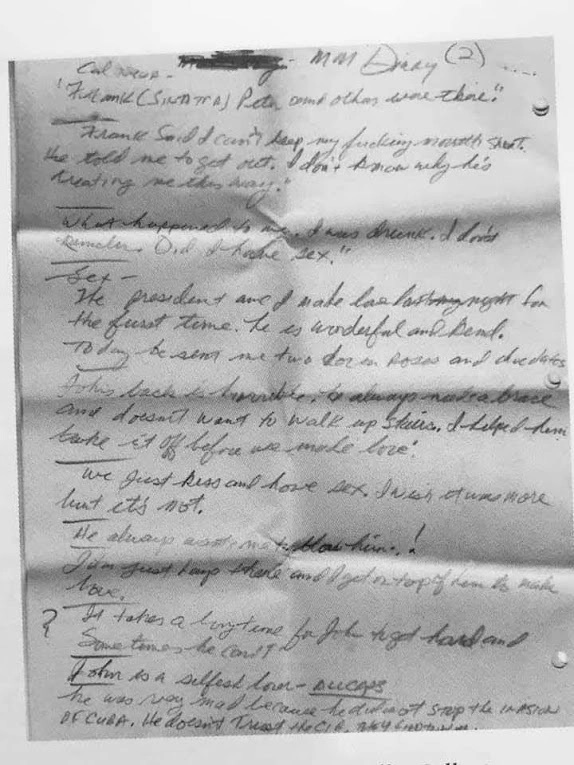
Purported transcriptions from Marilyn’s Little Red Diary as prepared by Michael Rothmiller between 1972 and 1983.
Samir Muqaddin published his memoir in 2012. He, too, like Rothmiller, asserted that he spent time reading Marilyn’s diary, not as much time as Rothmiller asserts that he spent reading it; but Muqaddin also asserted that he transcribed some of Marilyn’s entries. Shall we engage in a brief comparison of what each man alleged that they read and copied?
According to Michael Rothmiller, Marilyn wrote:
Bobby called. He wants to see me.
I think I made his [JFK’s] back feel better.
I’ll never have to suck another cock again.
He [JFK] always wants me to blow him.1The quotations highlighted in red can only be described as incongruent and contradictory—even mutually exclusive. In Rothmiller’s third quotation, Marilyn declared that she would never thereafter feel compelled to perform a gratuitous and derogative sex act or suck another cock again. Clearly her intent was to never again engage in that type of degrading accommodation. Never.
And yet, in the alleged entry following, purportedly a declaration regarding President John Kennedy’s continual sexual expectation, Marilyn suggested that she invariably complied and performed the expected act of fellatio, a Presidential Fellatio. Odd. At least to me.
And, too, when I initially read that, Marilyn’s use of the term blow in lieu of the more graphic and common term suck, which she used in the entry preceding, well, her use of blow sounded slightly anachronistic. Now, I am not an etymologist; but I am curious; and my curiosity prompted a brief investigation to discover a possible answer to the following query: when did the terms blow and blowjob enter the American lexicon? Consult the following links:
https://www.etymonline.com/word/blow-job
https://www.grammarphobia.com/blog/2011/07/blow.html
https://www.answers.com/earth-science/Why_are_blow_jobs_called_blow_jobsJohn and I made love in the pool.
Niketa is a horrible man and must be stopped. I’m scared there will be a war.
John called, he wants to see me again. He’ll have me picked up and taken to the hotel.
John told me about Castro and he must be stopped.
Bobby and I made love at Peter’s. He wants to see me again. This is our secret.
Frank invited me to the lodge [Cal-Neva]. He said it will be fun. He said never to mention Sam [Giancana] at the lodge. He’s mafia.
Bobby is gentle. He listens to me. He’s nicer than John.
Bobby said he loves me and wants to marry me. I love him.
Peter said Robert will come tomorrow. I don’t know if he will.
John is sending more men to Vietnam … The Communists must be stopped. It will be a long war.
Bobby called. He’s coming to California. He wants to see me.
According to Samir Muqaddin, Marilyn wrote:
This is for all the people who ever called me a dumb blond. I may be insecure, but not stupid. I only want to twinkle.
The FBI wanted me to do something for America. They sent Iron Bob to ask me if Arthur was a Communist. When I told him we weren’t that close he laughed and said you could get closer. He told me I should talk to Paula [Strasberg].
Iron Bob wanted the names of people with us during social engagements and information on Arthur’s meetings with the American Labor Party and the ACLU.
Paula and Lee told Arthur to come clean with the Committee but he said he would not sell out his friends. Don’t know why I gave that information. Guess I could be considered a sell out.
The best day of my life. I met Jack at Peter’s house. He was introduced as Senator John Kennedy and the next president of the United States. His confidence, intelligence, and charm struck me. It lit a fire. We started seeing each other.
I was with the next President and we made violent love.
The spy boys were really serious about killing Castro. Big Jim and a guy named Eduardo were actually involved in the Bay of Pigs. Jack never let them forget it.
We [Marilyn and the president] attended a meeting with the spy boys and mafia gangsters. They were discussing how to kill Castro. Johnny Roselli [allegedly also one of Marilyn’s many mobster lovers] boasted about the Mafia’s ability to infiltrate anybody’s security to kill them. They had a pill to cram up Castro’s butt. [Who was gonna do the cramming?]
Peter asked me to sing Happy Birthday during Jack’s party at Madison Square Garden. I finally met his brother Bobby, It was fun but didn’t work out.
I asked Bobby again about us. He told me don’t be ridiculous. Said he was going to become President after Jack and I’m not going to ruin it. Bobby found out about my diary. Can’t believe he raised holy hell for writing about us. Told me to destroy it. Never thought he would react like that.
Couldn’t reach Bobby and he won’t call back.
The dirty bastard changed his number. He thinks he going to do me like his brother did. I’ll fix them all.
I met Jimmy Hoffa at Frank’s party. Made a big fool of myself. Drank too much and smoked too much. Sam [Giancana] and him were asking about Bobby. What did I say?
Peter called. Bobby is coming tomorrow. They want me to call off the press conference. Too late.
Bobby was really mad. Acted crazy and searched all my stuff. Told him it’s mine. I’ll never let him have it.
It is extremely difficult to read the preceding purported quotations from Marilyn’s Little Red Diary and maintain a moderately straight face; and the entries that Robert Slatzer claimed he read in Marilyn’s diary are just as preposterous along with the assertions made by Ted Jordan and Jeanne Carmen regarding Marilyn’s diary entries. Obviously, the quotations proffered by Rothmiller do not read at all like the quotations proffered by Samir Muqaddin; their timber and word structure are completely different; and nothing offered by either quoter reads at all like Marilyn’s actual writings, found in the book Fragments, published in 2010. While Marilyn’s actual writings are mostly stream-of-consciousness and have a poetic coloration reminiscent of the poet e e cummings, Rothmiller turns her into a prepubescent female Earnest Hemingway. Once again, as I have already noted, what Rothmiller asserts came from Marilyn’s diary are so sophomoric they are comic. Besides, based on the book, Fragments, it is clear that Marilyn was a poor speller. Also, she frequently crossed-out words, wrote disjointedly and frequently linked her disjointed thoughts and entries with arrows; and neither Muqaddin nor Rothmiller, not to mention Slatzer, Jordan and Carmen, even denoted those salient facts regarding Marilyn’s actual writings and entries, very evident and on display in the actual journals written by Marilyn and found by Lee Strasberg’s widow, Anna.
In his memoir about his association with Marilyn, Norman Rosten, her poet friend, published the following Marilyn composed poem, entitled “To the Weeping Willow”:
I stood beneath your limbs
And you flowered and finally
clung to me,
and when the wind struck the earth
and the sand—you clung to me.
Thinner than a cobweb I,
sheerer than any—
but it did attach itself
and held fast in strong winds
life—of which at singular times
I am both of your directions—
somehow I remain hanging downward the most,
as both of your directions pull me.
In one of the many notebooks discovered by Anna Strasberg, Marilyn wrote a similar poem. Evidently, being pulled by life’s both directions, toward living and toward dying we can only conclude, was a significant theme and a difficult struggle for Marilyn.
Life—
I am both of your directions
Life
Somehow remaining hanging downward
the most
but strong as a cobweb in the
wind—I exist more with the cold glistening frost.
But my beaded rays have the colors I’ve
seen in a paintings—ah life they
have cheated you
In another notebook, Marilyn wrote:
Oh damn I wish that I were
dead—absolutely nonexistent—
gone away from here—from
everywhere but how would I do it
There is always bridges—the Brooklyn
bridge—no not the Brooklyn Bridge
because But I love that bridge (everything is beautiful from there
and the air is so clean) walking it seems
peaceful there even with all those
cars going crazy underneath. So
it would have to be some other bridge
an ugly one and with no view—except
I particularly like in particular all bridges—there’s some
thing about them and besides these I’ve
never seen an ugly bridge
The following quotation is a brief excerpt from a long lament written by Marilyn during her marriage to Arthur Miller. The editors of Fragments date the passage to 1958, obviously during the spring of that year. She is dissatisfied with what has become a sad and loveless marriage, a hopeless situation, caused, she believes, by the pressures of her career, pressures that she can endure and has endured, but Arthur cannot. She has decided to take care of herself because that is all she can do.
starting tomorrow I will take care of myself for that’s all I really have and as I see it now have ever had. Roxbury―I’ve tried to imagine spring all winter―it’s here and I still feel hopeless. I think I hate it here because there is no love here anymore. I tried to fight what with my being I knew was true―that due to pressure (it’s going to sound like a telegram) that have come in my work (it’s funny what I’ve always accepted even the worst―tried to oppose it if it meant jeopardizing my work) he could not endure (he is from another land) though I felt (innocently, which I am not) that what I could endure helped both of us and in a material way also which means so much more to him than me even […].
In my opinion, the preceding few quotations of words actually written by Marilyn speak loudly for themselves. Marilyn mentions John and Robert Kennedy once in one of her notebooks. Before accepting a request for an interview, Marilyn required the submission of questions in advance. Apparently an interviewer wanted to know the persons that she admired the most. Along with several other persons, Eleanor Roosevelt and Greta Garbo, for instance, she stated that she admired the president and Robert Kennedy because they symbolize the youth of America―in its vigor its brilliance and its compassion. Nothing that has been alleged to be in Marilyn’s Little Red Diary appears in her actual journals: Fidel Castro, Jimmy Hoffa, Frank Sinatra, the MOB or mobsters, intimate excerpts about love affairs or romances or little green men, Murder Incorporated, the FBI, the CIA or the Bay of Pigs fiasco do not receive as much as a passing mention. She does mention romance occasionally, but only in an abstract, a poetic sense. Additionally, Marilyn did not express any desire to assume the cloak and crown of First Lady nor to ceremoniously receive then wear, as a result of a marriage to political royalty, any sort of garland diadem.
In Chapter XV of Bombshell, Rotson invokes the Rashomon Effect, a concept based on the now revered Japanese movie Rashomon, written and directed by Akira Kurosawa. Released in August of 1950, Rashomon explores, considers and attempts to explain why eyewitnesses are often unreliable. Remarkably, Rotson uses the Rashomon Effect as a way to dismiss the accounts of Robert Slatzer, Jeanne Carmen, Frank Capell, and then later, in Chapter XVI, to dismiss Anthony Scaduto, Milo Speriglio, Lionel Grandison, Sr. (Muqaddin) and Donald Wolfe.
Wolfe was a friendly guy who dropped many names and presented many details that added up to nothing, Rothmiller asserted and then explained: It’s a nice technique to create an illusion of knowledge, which, of course, Wolfe did not actually possess (Rotson 194); and Rotson places biographer Donald Spoto in the category of an unwitting accomplice in the LAPD’s disinformation campaign, a clever campaign designed to obscure the facts pertaining to Marilyn Monroe’s murder, obscure Robert Kennedy’s actual location that Saturday in August of 1962 and to bewilder the public with continually changing stories. But amid all the hysterical theorizing, Rotson equivocates, there was always a hint of the truth―that her death was no accident, not suicide and not misadventure, but murder. A murder of convenience (Rotson 194). An interesting and critical part of how Rotson casually disfigures Rashomon is this: the persons dismissed as unreliable eyewitnesses were not eyewitnesses to anything pertaining to Marilyn Monroe’s life or her death.
Robert Slatzer was a smooth and smart operator, Rotson asserted, but then added that the Ohioan was also a longtime friend of Marilyn’s (Rotson 142). Slatzer was smooth and he was smart; but he was not Marilyn’s friend. Noble “Kid” Chissell, Slatzer’s friend, a former boxer turned actor, initially testified that he witnessed the Mexican wedding but later recanted and admitted to Joseph Jasgur,2Jasgur was a photographer who worked with Norma Jeane during her modeling career. He often took credit for discovering Marilyn Monroe and also for creating Marilyn’s fame and fortune.
Following the example set by several other photographers who worked with Marilyn, Jasgur also asserted that he had a romantic and sexual relationship with the young model.
The William Randolph Fowler Collection, Box 21, Folder 15, pages 1, 2 and 8. Revealed in a 1991 letter from Joseph Jasgur to Will Fowler.a Marilyn photographer, that Slatzer offered him money to lie. Chissell also asserted that Slatzer did not even know Marilyn, never did. Rotson’s dismissal of Slater was certainly justified because Slatzer was a fraud,3Robert Slatzer claimed, in his 1974 publication, that he interviewed Patricia Newcomb, interviewed her not once but several times. After Slatzer’s book appeared, Bruno Bernard telephoned Marilyn’s close friend and press agent from Munich, Germany. Bruno was writing an article about Marilyn for a magazine and wanted Pat to clarify who this mystery man, Robert Slatzer, was. Pat told Bruno she did not know a Robert Slatzer, had never met him.just as Jeanne Carmen was; and Frank Capell’s poisoned politics certainly made him suspect; but Rotson implies that Capell was unjustly treated merely because he did not accept the LAPD’s version of how Marilyn died; and therefore Capell found himself discredited one moment and smeared the next. Sure, Capell was a Red-baiter and an anti-Kennedyite; but according to Rotson, those facts did not negate everything Capell had to offer; those facts merely tainted it (Rotson 178). Tainted? Even Anthony Summers admitted that Capell’s poisoned politics made his 1964 pamphlet worthless; and then Summers, like Norman Mailer, who also dismissed Capell as surrealistic, proceeded to promote and advance Capell’s assertions by repeating them.
And yet, what did Capell actually offer other than innuendo and cleverly worded accusations of misdeeds by Robert Kennedy, who Capell called the most dangerous Commie in America? Capell, like Slatzer and Carmen, did not offer any real evidence that actually romantically tied Marilyn to Robert Kennedy or proved that the attorney general was involved, in any form or fashion, with the movie star’s death. Norman Mailer eventually admitted that he fabricated the Marilyn/RFK romance to sell books. Actually the fabricated romance came from Capell; and Mailer also admitted that he did not even believe the actress and the attorney general were romantically involved.
But even more important than the preceding, Rotson failed to mention Capell’s mendacity and deceitfulness or his association with Jack Clemmons, who makes his obligatory appearance in Bombshell as an concerned eye-witness.
Briefly, Frank Capell, in confederation with Sgt Jack Clemmons, John Fergus and Norman Krause attempted in 1964 to falsely smear the US Senator from California, Thomas Kuchel. A liberal Republican, Senator Kuchel was Robert Kennedy’s ally. Both men wanted the legislation instigated by President Kennedy in 1963, later modified into the Civil Rights Act of 1964, passed through Congress and codified into law. Ultraconservative Capell, like J. Edgar Hoover, hated Robert Kennedy and feared his rise to the presidency from his New York US senate seat; and Jack Clemmons shared Capell’s political ideology. Capell’s attempt to link the attorney general to Marilyn’s death was motivated by that hatred and Capell’s fear of another Kennedy presidency. Capell was not motivated by any altruistic need to expose the facts or the truth; and neither was Jack Clemmons. A Grand Jury indicted all four of the conspirators and charged them with conspiracy to commit criminal libel and wrongfully attempting to smear Senator Kuchel in order to affect his moral reputation: they accused the senator of public drunkenness and engaging in a public homosexual act for which the senator was allegedly arrested, finger printed and booked. All four of the charged agreed to plead guilty to lesser charges and to publicly apologize to Senator Kuchel. Frank Capell received three year’s probation and a $500 fine. While the charges against Sgt Clemmons were eventually dropped, he was forced to resign from the LAPD. Regarding Slatzer and Carmen, they were motivated primarily by avarice―and a desire for the spotlight.
In Bombshell, we are told that Michael Rothmiller consulted with former Sgt Jack Clemmons. Together, the two officers studied, ratified and investigated Marilyn’s death for more than six years before the former sergeant died unexpectedly in 1998, meaning that their study, investigation and ratification of Marilyn’s murder began sometime prior in 1992. True to form, Sgt Clemmons reported details to Rothmiller that contradicted testimony the sergeant offered during the thirty years following Marilyn’s death.
According to Rothmiller, Sgt Clemmons asserted that he touched Marilyn’s cold body, squeezed her neck and shoulders, an examination he never reported or otherwise even mentioned; and also, according to the former sergeant, he observed that Marilyn’s body displayed extensive bruising, an observation that contradicted Dr. Noguchi’s examination and signed autopsy report, which revealed only one small bruise. Despite Noguchi’s observations, Sgt Clemmons concluded that Marilyn’s corpse had been bruised post mortem, when she was moved around and positioned by ghouls for a series of photographs, including two staged “telephone” images. Sgt Clemmons believed that the photographs with and without the telephone in her hand were part […] of the phony suicide scene’s staging, photographs that would only be released if they aided the cover-up (Rotson 163-164). None of the photographs mentioned by Sgt Clemmons have ever been seen, of course, by anyone other than the former sergeant and unidentified members of the LAPD and the OCID.
Ever forthright, Jack Clemmons, a paragon of honesty, reported other details to Rothmiller that the former sergeant never mentioned to any other person for thirty years. For instance, according to Rothmiller according to Sgt Clemmons: 1) doctors Greenson and Engelberg admitted that they turned Marilyn onto her back, checked her vital signs and tried to revive her; 2) the sergeant stumbled upon Dr. Greenson flushing pills down the toilet; 3) the sergeant’s superiors ordered him to sign his altered written reports and to sign several reports that he did not write, reports that contradicted what Sgt Clemmons had observed at Marilyn’s death scene; and 4) to initial several photographs that he did not take (Rotson 161-164). He objected to what he was ordered to do and would not sign the falsified reports. However, he initialed several photographs, but he refused to sign the obviously staged telephone images. Sgt Clemmons asserted that Police Chief William Parker and Capt James Hamilton forged his signature on the false reports; and he also repeated for Rothmiller two consistently told yarns: 1) in another part of Marilyn’s hacienda, the sergeant found Eunice Murray operating a washing machine and dryer not long after he arrived at Fifth Helena; and 2) he searched but did not find a drinking glass in Marilyn’s bedroom or her bathroom.
The preceding revelations are interesting, and slightly shocking, to say the least. To his friend, Robert Slatzer, Sgt Clemmons reported in 1973 that he never wrote any reports about that Sunday morning: he was not on scene long enough to justify a report, he noted. Besides, Detective Sgt Robert Byron assumed the official investigation and the responsibility for writing all official reports. Additionally, Sgt Clemmons reported during several interviews, that he did not even approach Marilyn’s body. From her appearance, he knew she was dead; and Dr. Greenson testified that he and Dr. Engelberg did not attempt to revive Marilyn because they, too, knew immediately that she was dead.
Dr. Greenson asserted that Marilyn had a telephone receiver in her hand, which he removed so Dr. Engelberg could telephone the police. As far as Dr. Greenson’s pill flushing is concerned, are we expected to conclude that he actually flushed away Marilyn’s Nembutal; and therefore, she never swallowed them? If so, that is certainly an odd expectation without any supporting evidence. Additionally, Sgt Jack Clemmons did not, at any time during previous interviews or testimony, contend that he actually took photographs of Marilyn’s body or the environs in which Eunice Murray and Dr. Greenson found the actress.
One strange element of Sgt Clemmons’ assertion that Marilyn’s suicide scene had been staged, neatly arranged, made even stranger by Rotson’s assertion that two OCID detectives actually arranged the scene, is this: if a contorted corpse is commonly found at the scenes of drug overdoses, why did those who staged Marilyn’s suicide scene position her in what Sgt Clemmons always called a soldier’s position? Those OCID detectives must have been experts at cover-ups, something in which the OCID often engaged, according to Rotson. Certainly the ghouls who arranged the scene would have known that an overdose of sleeping pills always caused the unfortunate victim to contort, at least according to Sgt Clemmons. Those men could have arranged Marilyn’s body in any position necessary to create a unquestionably convincing artifice; and according to every person who observed or handled Marilyn’s body, rigor mortis was in an advanced stage, meaning that her body would have maintained any shaped position. Why did the stagers and riggers choose a soldier’s position? Besides, the entire scenario conflicts with known history. Where was Eunice Murray? We know she was there.
Additionally, why did Sgt Clemmons withhold, for thirty years, the information that he purportedly imparted to Michael Rothmiller? He had ample opportunities to reveal what he allegedly knew. As with all unsolved homicides, Rotson explained, cops withhold certain key details that only the killer would know. He kept the details secret, known only to himself, while hoping that one day the details would prove or disprove a person’s knowledge of the killing (Rotson 162). Which participant in Marilyn’s murder was Sgt Clemmons hoping to entrap with details only the participant would know? Long before 1992, most of the main characters who were allegedly involved in Marilyn’s purported murder, excluding Fred Otash, had already relocated into eternity: the middle Kennedy brothers, John in November of 1963 and Robert in June 1968; Police Chief William H. Parker in July of 1966; Dr. Ralph Greenson in November of 1979; Peter Lawford in December of 1984. Fred Otash lived until October of 1992. All dead.4Capt James Hamilton retired from the LAPD in June of 1963, preferring to work for the National Football League and then Commissioner, Pete Rozelle; but despite my ardent efforts, I have not been able to locate an obituary for Capt James Hamilton or pinpoint the date of his death. I am confident, however, that he departed from Planet Earth several years before the publication of Bombshell.
The net result of all that dying was this: not one word of testimony purportedly spoken by Sgt Jack Clemmons, as reported by Michael Rothmiller, could or can be corroborated.
And yet, Rotson offered still another amazing reason why the former sergeant revealed the information to Michael Rothmiller: what Sgt Clemmons had been ordered to do―shut up and never speak about Monroe’s death again―greatly bothered the sergeant; and he asked that I [Rothmiller], in some fashion tell his story to the world (Rotson 162). Amazing, to say the least, considering that Sgt Clemmons never stopped talking about Marilyn Monroe’s death.
Donald Wolfe praised Sgt Jack Clemmons, lauded his integrity and his dedication to finding the facts and revealing the truth about the cases with which the Los Angeles policeman was involved. After Sgt Clemmons’ 1998 death, Wolfe lamented that the world would be a lesser place without his friend and his friend’s dedication to honesty, certainly an undeserved, unwarranted and false adulation, at least in my opinion; but then, Donald Wolfe and the sergeant became close friends. I can only conclude, though, that Donald Wolfe chose, refused to tell his honest friend’s true story. Why?
Michael Rothmiller, as I have already noted, appeared in Wolfe’s The Last Days of Marilyn Monroe; and oddly enough, Sgt Clemmons consulted with Michael Rothmiller during the same time frame during which he also consulted with Donald Wolfe. As I have also already noted, the former OCID detective did not reveal to Wolfe everything he purportedly knew about Marilyn’s death. None of the details that Sgt Clemmons revealed to Michael Rothmiller appeared in Wolfe’s literary effort about Marilyn, originally published in 1998 and re-issued as an eBook in 2012. Why? A skeptical person would ask: which Sgt Jack Clemmons was being honest, the one consulting with Wolfe or the one consulting with Rothmiller? Significantly, too, Donald Wolfe invariably reported what Sgt Clemmons actually believed, the testimony he frequently offered about Marilyn’s death: Dr. Ralph Greenson murdered Marilyn Monroe with an injection directly into her heart that was witnessed and reported by the ambulance attendant James Hall.
Even though Frank Capell appeared in Donald Wolfe’s book and received a healthy dose of complementary support, Wolfe conveniently had a lapse of memory and failed to mention Capell’s association with Sgt Jack Clemmons and each man’s involvement in the Thomas Kuchel Incident; and none of those facts appeared in Bombshell.
But the pièce de résistance follows hereafter. Not long after Marilyn’s death, Sgt Clemmons began receiving death threats and warnings to keep his mouth shut. Rotson reports that the threats continued even after he left the department after a falling out with Chief Parker over Monroe’s death and an unrelated political brochure (Rotson 164: emphasis mine). Certainly, Sgt Clemmons did not leave the LAPD on his own volition; and to label Frank Capell’s political anti-Kennedy diatribe an unrelated political brochure stretches something that could be called harmless literary license into something certainly unethical if not iniquitous.
Finally, returning briefly to the sergeant’s assertions regarding Eunice Murray and the washing machine, the missing drinking glass and the neat condition of Marilyn’s bedroom, as I have noted many times in the past, more times than Carter’s got little liver pills: 1) Marilyn did not even own a washing machine or an automatic clothes dryer: she used a laundry service, as extant receipts conclusively prove; 2) as clearly revealed by police photographs, she had a drinking glass in her bedroom; and 3) as clearly refuted by those same police photographs, Marilyn’s bedroom was not neat and tidy. Should we conclude, therefore, that the sergeant’s testimony is a classic example of the Rashomon Effect?
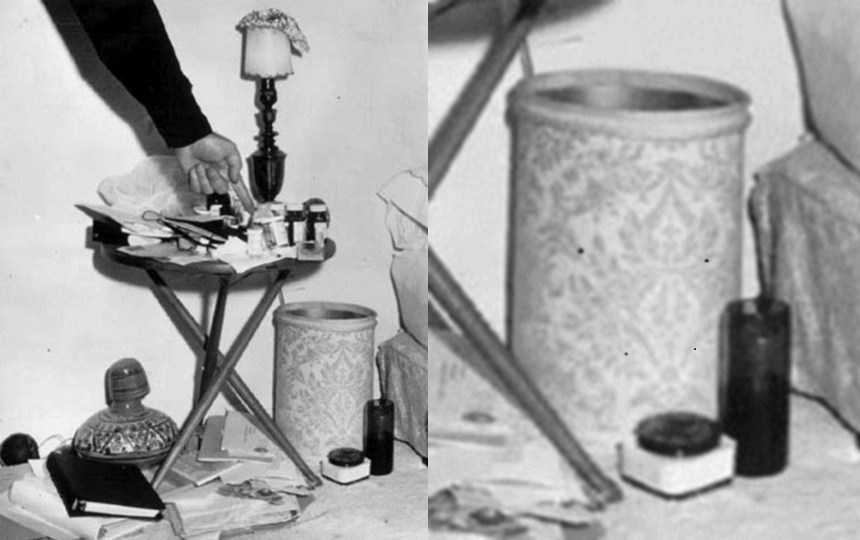
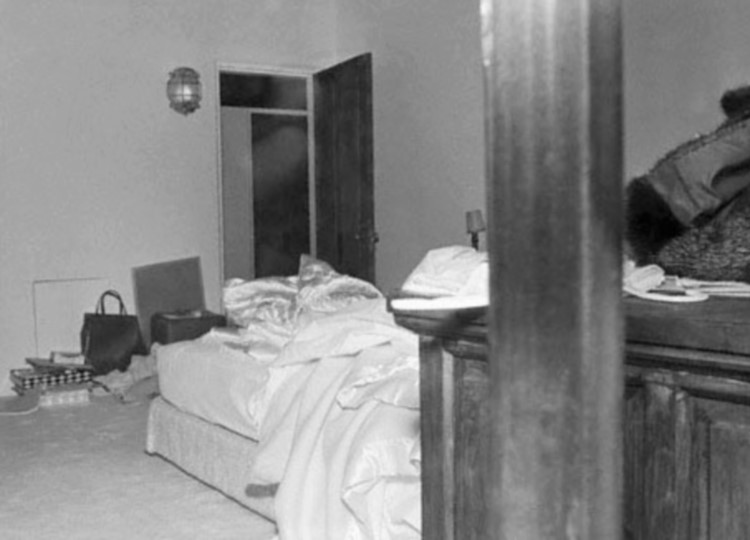
Rotson mentions Will Fowler, who I have already referenced in a footnote. Fowler was a journalist to whom Slatzer tried to sell a short article he had written about how Marilyn’s death was a conspiracy […] (Rotsom 176). The preceding assertion by Rotson is actually incorrect and only tells a tiny fraction of a story that involves not only Will Fowler and Robert Slatzer, but Frank Capell as well.
In Murder Orthodoxies, I dedicated many pages and approximately thirty-thousand words to the shenanigans of Robert Slatzer and the writing triumvirate of Slatzer, Fowler and Capell, a joint business adventure that, after its inception, contractually involved only Slatzer and Will Fowler; but when Slatzer suggested to Fowler that he should borrow liberally from Capell’s pamphlet, without the corresponding credit, Fowler cautioned Slatzer against plagiarism and suggested including Frank Capell in their literary enterprise. Upon Fowler’s insistence, Slatzer agreed to invite Capell to participate, and the associated contracts are displayed below.
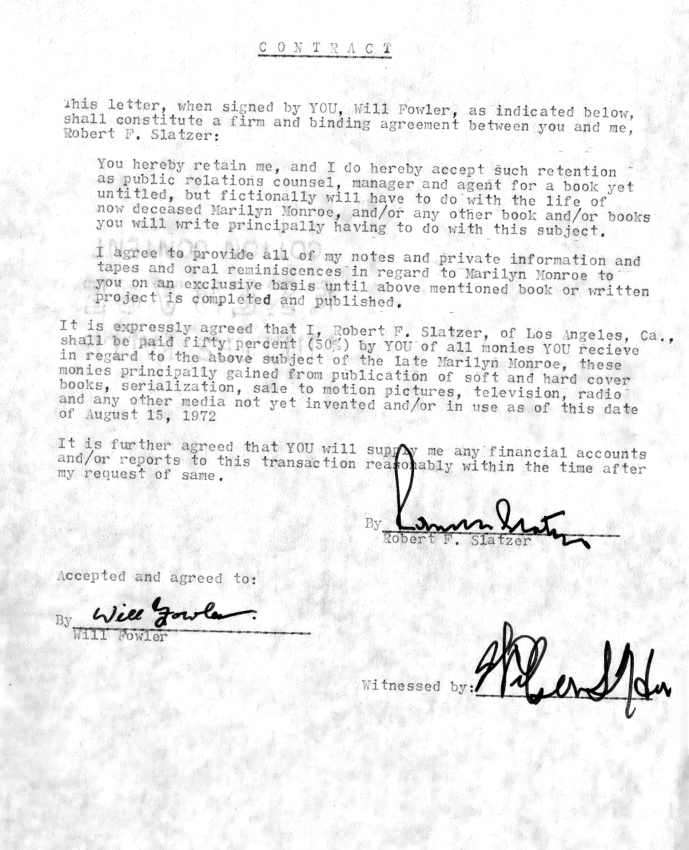
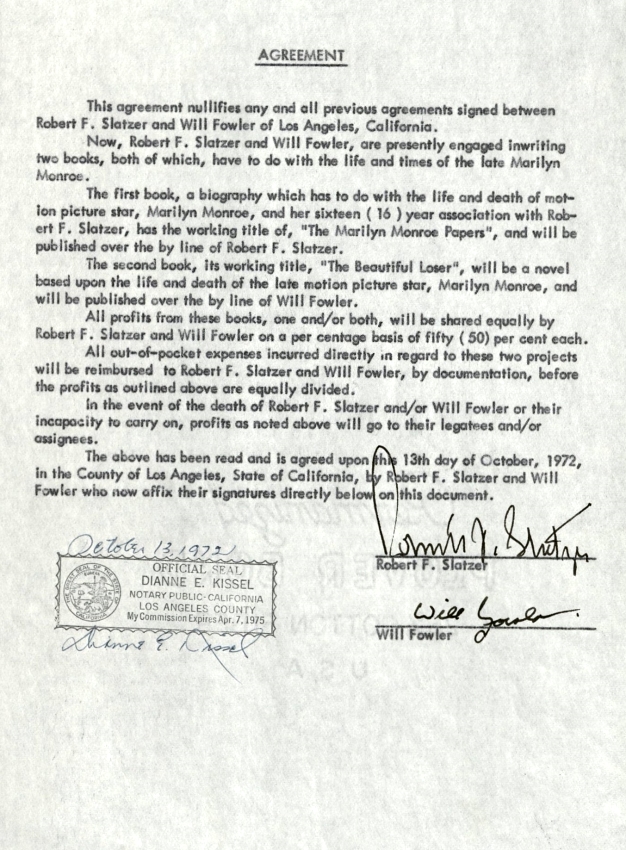
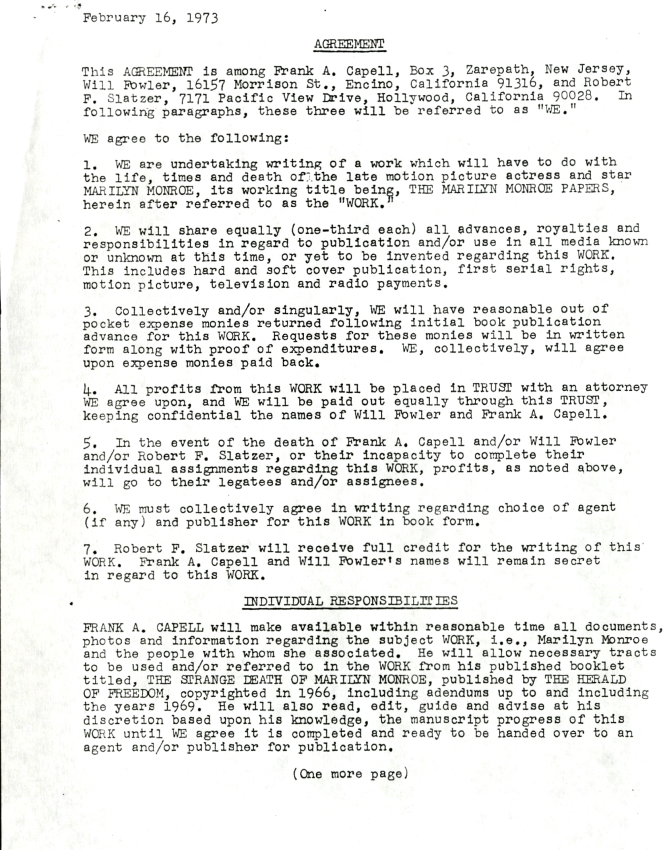
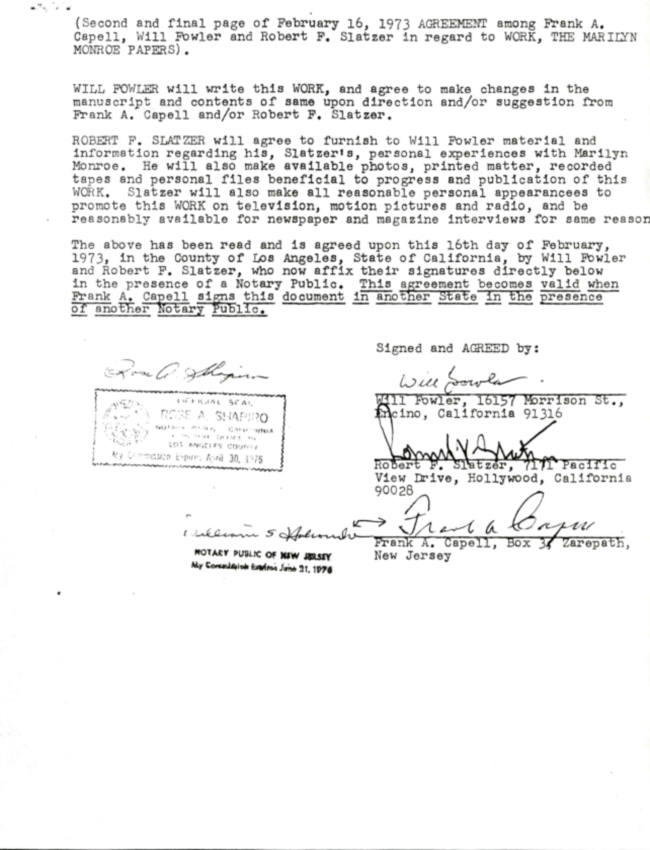
The preceding contracts were included in the over nine-hundred pages of documents that I obtained in late 2018 from “The William Randolph Fowler Collection” housed in the Oviatt Library, California State University at Northridge. The actual story of how The Life and Curious Death of Marilyn Monroe came into being is long but interesting; and all the documents that I obtained prove beyond any doubt and to a mathematical certainly that Robert Slatzer did not write the book for which he has been credited and the book was, and is, primarily a fabrication. If you are interested in reading more about Robert F. Slatzer, his apocryphal book, and his association with Will Fowler and Frank Capell, along with several other writers and editors, follow this direct link to Murder Orthodoxies, An Alleged Second Husband.
The irony in all the preceding is this: while Bombshell invokes the Rashomon Effect in order to dismiss Robert Slatzer as an unreliable eyewitness, even though he eye witnessed nothing, Rotson accepts the stage prop that Slatzer created, quite possibly with help from Frank Capell, Marilyn’s infamous Little Red Diary; and that acceptance is as rich as a French Silk pie.
Not one piece of credible or verifiable evidence has been presented during the past forty-five plus years which proves that Marilyn’s Red Book of Secrets ever existed; and there is absolutely no credible or verifiable evidence presented in Bombshell which proves that Michael Rothmiller actually saw and even read a diary, much less the diary which the movie star herself disavowed. She acknowledged that she occasionally wrote about the events of her life. Thus, Marilyn’s journals, the ones accidentally discovered by Lee Strasberg’s widow prove conclusively what Marilyn wrote about and how she actually wrote. The red diary as inconsistently and absurdly described by Robert Slatzer, Jeanne Carmen, Samir Muqaddin, Ted Jordan, and now Michael Rothmiller, never existed. Ted Jordan, who wrote his own fairy tale about a relationship with Marilyn which also included her delphic diary, finally admitted, after he told several contradictory stories about the red book, that it never existed. Marilyn’s Little Red Diary never existed.
